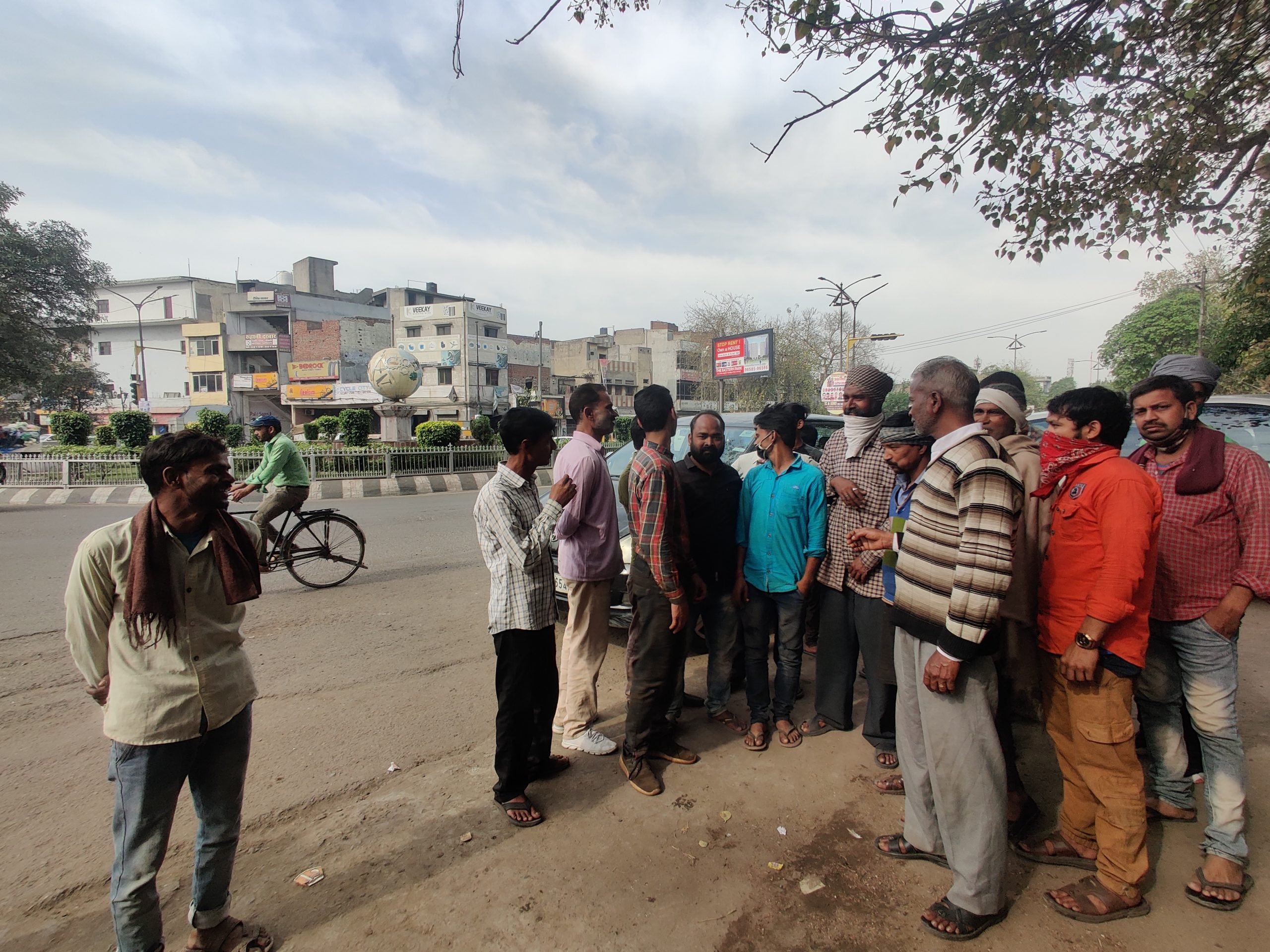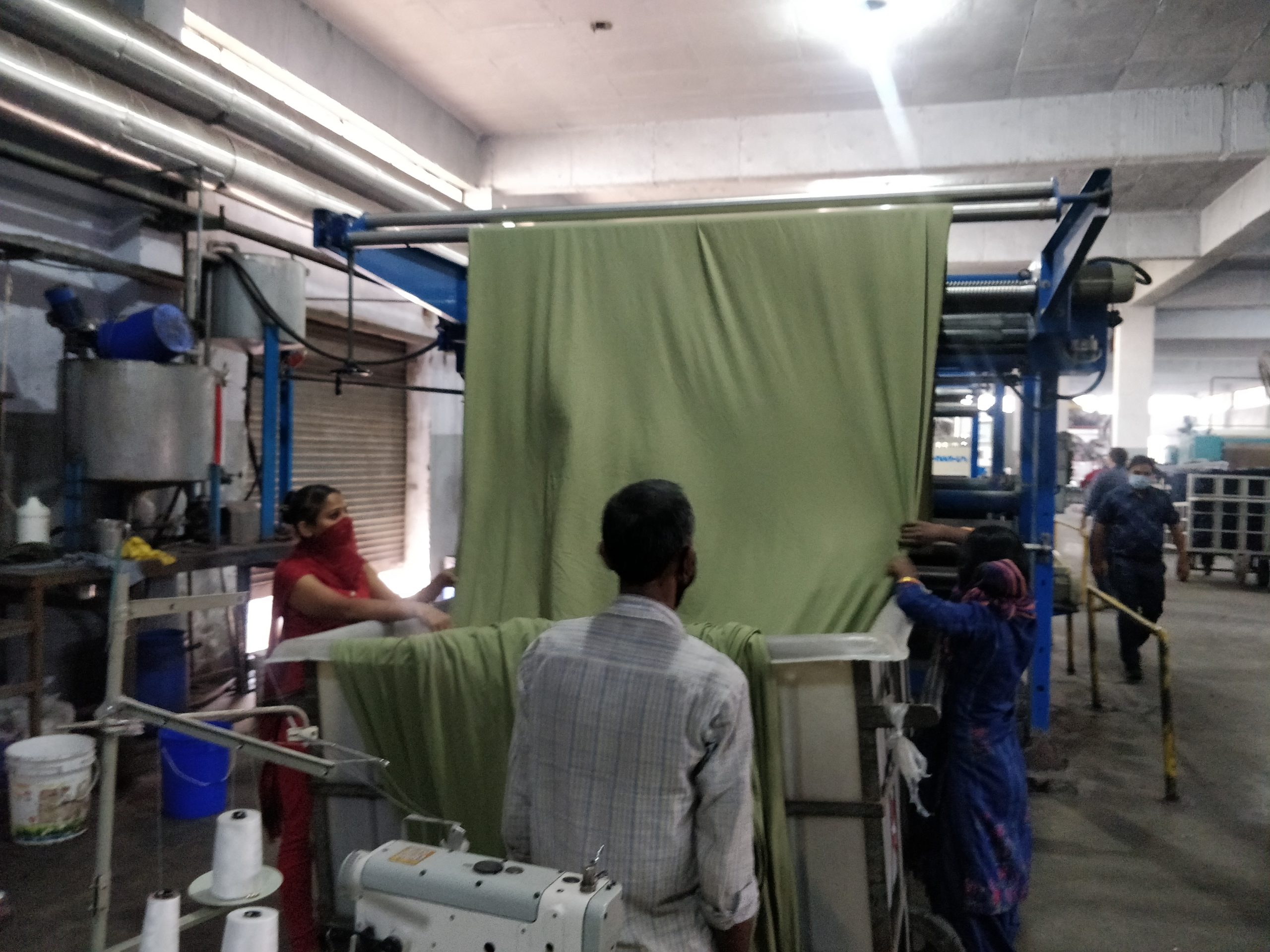Lockdown Fallout: Distress Stalks Garment Workers in Ludhiana
Image Courtesy: The Print
It is a year since the central government announced a countrywide lockdown to stop the dreaded COVID-19 pandemic from spreading. Now, in the shadow of the second wave of infections, labourers in Punjab’s industrial town Ludhiana are still getting low wages, while the city confronts acute joblessness, writes VIVEK GUPTA from Chandigarh.
——
BORN and raised in village Katghar of Uttar Pradesh’s Jaunpur district, Ved Prakash landed in Ludhiana about ten years ago, seeking a better future.
His first job was as a helper in a garment factory at less than Rs 100 per day. Later he learned to sew clothes and in a few years, he began earning Rs. 20,000-25,000 a month.
The city, a textile and hosiery hub of North India, employs over ten lakh migrants from Bihar and Uttar Pradesh in normal times. It gave a lot to Ved until the COVID-19 exposed its dark underbelly.
Ved was among the thousands of desperate and dejected migrant workers who left Ludhiana on foot in the middle of last year’s lockdown after local industry and the government turned their backs on them.

A group of labourers at Ludhiana’s Vishkarma Chowk
The central government created uncertainty in the job market by extending the lockdown repeatedly. This made workers restless and frustrated, forcing them to march home on foot as train and bus services had also been shut in a bid to control the spread of the Novel Coronavirus, which causes the COVID-19 disease.
The lockdown completes a year on 23 March. A year on, Ved says, leaving Ludhiana was his only option last summer when he was left with neither enough food nor money to survive. “But the 1,000-kilometre walk home was equally hellish. The police beat us on the way, there were days of sheer hunger. I even saw people collapse,” says Ved.
Ved returned to the city last July after the Centre eased some restrictions and factories started hiring workers again. That does not mean the challenges before Ved and millions like him are over.
Since July, his income is less than half his pre-lockdown earnings. “I live on rent and my wife and child are also with me now,” he says. “Forget saving, managing expenses is really hard,” he says.
Rakesh Kumar from Ambedkar Nagar near Azamgarh in Uttar Pradesh says that barring a few factory-owners, most local industrialists refused to help their employees during the lockdown.
The lockdown completes a year on 23 March. A year on, workers say, leaving Ludhiana was their only option last summer when all they had was gone, food or money. But their distressed walks home were equally hellish. The police beat them on the way, there were days of sheer hunger. Some collapsed on the way.
“There were days we had no food. There were days we ate once a day. The situation forced many of us to leave the city in great pain,” he says.
He says the situation is still not normal. “Our wages are at an all-time low. We don’t know for long it will continue,” he adds.
Industry in a bubble, the poor end up losing
Ludhiana’s textile industry mostly employs skilled and semi-skilled workers who work in various garment-manufacturing processes, from dyeing to creating finished products.
Many workers are unskilled, mostly in jobs involving hard labour: packing, loading-and-unloading, cleaning up, and other general factory works.
Ved returned to the city last July after the Centre eased some restrictions and factories started hiring workers again. That does not mean the challenges before millions of workers are over. Since factories are down to manufacturing less than half what they did last year, and there is a shortage of raw material for garments, so workers are earning less too.
But if you ask industry representatives, the post-lockdown depression still hangs over businesses.
“Once garment factories in Ludhiana employed over ten lakh people. Now there are not even half as many,” says Ajit Lakra, president of the Ludhiana Knitters Association.

Labourers working in a textile factory in Ludhiana’s focal point
He says the ongoing economic slowdown and lack of demand and consumption are prime reasons for the consistent downfall in factory production and fall in employment ever since the lockdown.
“We thought the situation was becoming normal since there was a slight uptick in the winter season but the textile industry was recently severely hit by a hike in the cost of raw material. This prevented us from taking bulk manufacturing orders and we could not run factories at full capacity,” says Lakra.
He says the prices of cotton yarn have increased from Rs. 190 per kg (pre-lockdown) to over Rs. 300 per kg and so has the cost of petrochemical-based [synthetic] fabrics such as polyester that are massively used in local factories that manufacture sporting attire.
‘We thought the situation was becoming normal since there was a slight uptick in the winter season but the textile industry was recently severely hit by a hike in the cost of raw material. This prevented us from taking bulk manufacturing orders and we could not run factories at full capacity.’—Ajit Lakra, president of the Ludhiana Knitters Association.
Garment factories in Ludhiana are not accepting fresh manufacturing orders since the offer price is unviable considering their cost of manufacture. “The big garment retail brands are also in a fix because they are not in a position to increase retail prices due to the depressed state of the market,” he says.
Lakra blames the “cartelisation” of yarn-making mills and the monopoly of polyester manufacturers in India for the hike in raw-material prices. He says the textile industry will soon hold a protest in Ludhiana asking the government to intervene in the matter, which is hurting everyone from labourers to consumers.
Ram Pratap, the president of the Hosiery Workers’ Association which has over 2,000 members, says that since the lockdown, 30% of manpower has not returned to Ludhiana—yet wages have nosedived.
This is primarily for two reasons. The manpower of textile factories earns its wages on a per-piece basis. For instance, if they prepare five t-shirts in a day, they earn Rs. 500, or Rs. 100 per piece.
He says that before the lockdown, those who cut, stitched, or sewed would earn between Rs. 20,000 and Rs. 25,000 a month. During the peak seasons, they could even earn Rs. 30,000 in a month.
“Now, the monthly income is down to Rs. 10,000 or Rs. 12,000 or at most Rs. 15,000 if production increases. Since the production at factories is down to less than half, and every factory is short of raw material to produce enough garments, [so workers are earning less too],” explains Ram.
Even if factories go for full-scale production, there are not many buyers in the market. The rich might have started purchasing again, but the problem is that purchases are still not hitting mass scale as most people are sticking to purchasing just necessities.
“Factories will go full scale only when people like us start buying clothes from rehris [street vendors] or small shops in villages, towns and cities. That is when demand will [re]generate and factory workers will get more work,” said Ram.
Fluctuating prices of raw materials have also confused factory-owners, dissuading them from stocking up on larger quantities. The synthetic fabric market has become more unpredictable and cautious due to the rise in prices of petrol and diesel, which serve as the basis for manufacturing this kind of yarn.
Every segment has unique roadblocks
It is particularly worrying that the lockdown and its aftershocks have not hurt the entire workforce to the same extent. For instance, there has been an influx of labour into the unskilled market in Ludhiana, says Guddu Kumar, the president of a union representing daily-wage earners in Ludhiana. As a result, before the lockdown, a helper would typically earn a monthly salary of Rs. 10,000 to Rs. 11,000, but now some are getting Rs. 8,000 or Rs. 8,500 at most.
“This is because a lot of workers from Delhi and Mumbai have come here in search of work. This has created an excess supply while demand has not increased accordingly due to the economic slowdown,” he says.
Vishal Kumar works on a daily wage in a garment factory at Bhadur Ke Road, a hub of textile and hosiery units in the city. Before the lockdown, he would find work all through the month. After it, he has got work for no more than 15 or 20 days a month, which means he can barely earn enough for his family to eat.
A group of labourers at Ludhiana’s Vishkarma Chowk, where casual labourers often gather to look for work, had different grievances. Says Surjit, the domestic workers of Ludhiana have fixed daily-wage rates between Rs. 500-800 a day, depending on where they work, in construction for example, or doing tough manual tasks. “However migrant workers often accept lower than these wages, which disturbs the entire set-up,” he says.
Sachin Kumar, a garment worker from village Meer Khera near Lucknow in Uttar Pradesh, says factories in Ludhiana have not returned to normal. He, too, left Ludhiana on foot during the lockdown due to a tremendous sense of uncertainty about when factories would reopen as the Centre continuously extended the lockdowns. “After I returned to Ludhiana, I did not get the same job I had earlier, I found work elsewhere,” Sachin says.
Ludhiana is a textile and hosiery hub in North India, which employed over ten lakh migrants from Bihar and Uttar Pradesh before the pandemic. Now, a lot of workers from Delhi and Mumbai have come to Ludhiana in search of work. This has created an excess supply while demand has not increased accordingly due to the economic slowdown. The workers suffer as a result
Ludhiana’s labour officer, Baljeet Singh, says overall employability has improved since the lockdown but the labour department often receives complaints of retrenchment and non-payment of pending wages. “In several cases, the matter was reconciled after summoning the factory owners,” he says.
Ludhiana is also famous for manufacturing bicycles. However, there is one glimmer of hope here: There was an increase in sales of bicycles in the post-Covid phase.
This was a source of some relief for those who work in bicycle factories, says Jagdish Chand, the local president of a central trade union. The problem for cycle-makers is that their wages have stagnated.
“The government of Punjab has not revised the minimum wage for over a year. The rolled back a Rs. 400 Dearness Allowance announce on 9 May 2020, which would otherwise have been added to the minimum wages fixed by the state government,” says Chand.
DP Maur, a local leader of the Communist Party of India who actively engages in trade and labour-related issues, says the Centre issued several directions to factory owners to give their employees wages for the lockdown period but no one followed them. “The workers trudged to their native villages in great distress. Now, most of them have returned, thinking they will bring their lives back on track, but there is huge joblessness in Ludhiana,” says Maur.
The ongoing economic slowdown and lack of demand and consumption are prime reasons for the consistent downfall in factory production and fall in employment ever since the lockdown. However, there is one glimmer of hope here: There was an increase in sales of bicycles in the post-Covid phase, which was good for its workers too. As for the rest, the Centre issued several directions to factory owners to give employees wages for the lockdown period but no one followed them.
He blames slow economic growth for the current perilous situation. The industry was yet to recover from the Centre’s decision to put high-value currency notes out of circulation in November 2016 and its haphazard implementation of Goods and Services Tax. Then came the lockdowns, and that too has had a cascading effect on millions of people country-wide, he says.
“In the last five or six years, a situation has emerged in which neither industry nor workers ever could feel settled, and it is all thanks to the faulty economic policies of the central government,” says Maur.
The article was originally published in The Leaflet.
(Vivek Gupta is a senior journalist based in Chandigarh. The views are personal.)
Get the latest reports & analysis with people's perspective on Protests, movements & deep analytical videos, discussions of the current affairs in your Telegram app. Subscribe to NewsClick's Telegram channel & get Real-Time updates on stories, as they get published on our website.






















